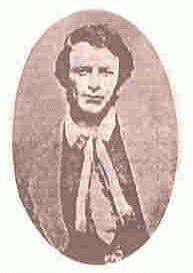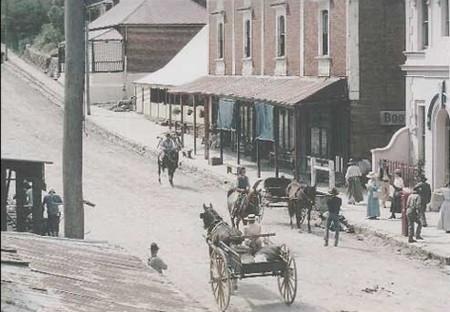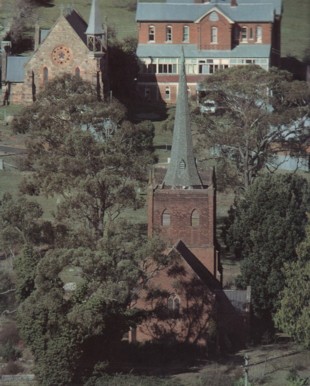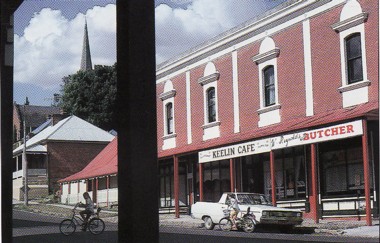Goldrush Bushrangers And Stagecoaches
 Growing up in the Central West of New South Wales in Australia has given me a love of history, and I have spent a lot of time over the years visiting and learning about towns and villages in the area.
Growing up in the Central West of New South Wales in Australia has given me a love of history, and I have spent a lot of time over the years visiting and learning about towns and villages in the area.
One of the easiest ways of doing this was visting my Mother’s family, who have lived around the area for a number of generations.
My grandparents lived at Carcoar for a number of years until the 1970s. After my grandfather passed away, my grandmother moved to Blayney, a larger town in the area.
Their old house, a former inn, is still standing!
Above left: The bushranger (outlaw) Ben Hall
Carcoar was once a major administrative and banking center, and was one of the earliest settlements in NSW.
As it was the first major center beyond Bathurst, Australia’s oldest inland city, it was expected that it would one day become a major regional center, but that didn’t eventuate, largely because the town was bypassed by the railway when the main western line was built.

A picture of Carcoar’s main street.
By the time the railway did arrive in 1888, it was only a branch line, and Carcoar had already been overtaken by the neighboring towns of Blayney and Orange.
The area was mainly agricultural, but as time went on, iron ore and copper were mined in the area. Gold was also discovered nearby during the 1850’s.
Carcoar provided an overnight stop for Cobb and Co Coaches, a stage coach firm that serviced much of eastern Australia until the early 1920’s.

A view of the village today.
The wealth of the region attracted bushrangers (outlaws), and the town was the scene of Australia’s first daylight bank hold up in 1863.
Two members of Ben Hall’s gang, Johnny Gilbert and John O’Meally, attempted to hold the Commercial bank up, but fled empty handed when the teller produced a pistol and took a shot at them.
Hall himself held up the Rev. James Adam, but decided against robbing him because he was such a ‘nice bloke’.
A couple of Hall’s accomplices were killed during their activities in the area, and Hall himself was killed in 1865 near the town of Forbes after a shootout with police.
Frank Gardiner, another early bushranger, was active in the area as well. He was involved in cattle ‘duffing’ (rustling).
Situated just off the Mid Western Highway, Carcoar is a small village located 258 km (about 160 miles) west of Sydney, and 52 km (about 32 miles) south-west of Bathurst in NSW.
Today, the village is a virtual snapshot of the 19th century, with many of the original buildings still standing.
As a matter of fact, walking down the main street of the place with my daughter a few weeks back, I felt just like ‘Marty’ in the ‘Back To The Future’ movies.

A later picture of Carcoar’s main street.
The general store is still just as it was when built back in the 1800’s, with the original counter and shelving still in place.
Australia Day (January 26) is a great day to visit the area, with stage coach rides, period dress and the reenactment of historical events.
Sources and Links:


lovely piece!
Rev James ADAM (b ca 1833, d 1911) was my great-grandfather.
He is believed to have been returning from Forbes to Cowra, with about 80 pounds collected for the building of a Presbyterian Church there ca 1862-63, when, as a published record would have it, he rounded a bend & stumbled onto HALL’s group of men.
He got off his horse, adjusted his hat & gloves, walked up to the men, shook each by the hand, enquired after their personal well-being, & offered to give their children religious instruction.
He was allowed to proceed, & it is alleged, after he had mounted his horse & walked it out of view, that HALL said to his men – “If any man touches Parson ADAM, I’ll put a bullet through him.”
It is believed, as part of family folk-lore, that he had met up with HALL earlier, & in a coach, when he had spoken to him without any prejudce, being then also solicitous of HALL’s well-being.
ADAM, alternatively known thereabouts as “the Apostle of the Saddle,” would have known full well who HALL was, & so must have been a very cool customer – or rather trusted to his faith!
My grandmother, Margaret Paton ADAM, was born in the Carcoar Manse, just below St James’s Church, in 1874; she married my grandfather in Blayney in 1898, & lived with my family in the last years of her life, up until her death in 1960, when I was only 11 years old.
She recounted (probably as told her by her mother) that Johnny VANE had called into the house in Carcoar & told her mother, Betsy ADAM alias SPENCE (1836-1932), the story of the meeting on the Forbes Road.
I am unable to independently corroborate any of it, but it seems that the story took on a life of its own, & I suspect was probably largely true.
Regards,
Chris PIGOTT, Potts Point, N.S.W.
G’day Chris,
Thanks for shedding light on that for me, I really appreciate it.
I have heard that story about your great grandfather from a number of sources, including from members of my own family.
My mother’s family lived around the Carcoar – Blayney – Newbridge area for a number of years.
Coincidently, there was a branch of the Pigott family that lived next door to my school in Bathurst for a number of years.
Cheers.
Watching Peter Allen movie recognized partly filmed in Carcoar. A bit more history my parents lived in Carcoar as did I. My grandfather James Stammers was the first white baby boy born there, I have a newspaper clip.
Retracing my family history I have discovered my family Irish roots back to Michael and Bridgette Burke, nee Comerford who immigrated to Australia from Templemore Tipperary in 1838 aboard the ‘William Metcalfe’, along with brother and sister couple John Bourke and Ellen Comerford. Assisted passage immigrants. Comerford being the correct modern spelling of the name which dates back to Irish nobility from Kilkenny. Parents William and Eliza Bourke are said to be already in the colony according to the Tipperary Imigrant index. This precedes the potato famine and mass Irish immigration of 1845.
The wealthy and powerful Comerford family were driven from their land to exile in ‘Connaught’ in the Cromwellian redistribution of 1653. The roof was shot off one of their castles ‘Ballybur’ by Cromwell. At this point in history many native Irish were forced from their homes, slaughtered and sold off as slaves to the new world. Various former fighters known as Tories and Raparees(former nobility) returned to the hills of Tipperary and fought a guerrilla war against the protestants which involved highway robbery and making the countryside an unwelcome place for travellers. As we well know this war continued until nearly the end of the twentieth century in Ireland with the terrorist activity of the IRA. It is interesting to note that Ned Kellys father is also from Tipperary.
Historical texts often cite the motives for bushrangering as political, however they don’t define exactly what implys. This was a fiercely nationalistic Irish catholic family who upon arrival of the two brothers and their wives in the colony of NSW travelled immediately to the area of MT Macquarie, Fell Timber creek near Mandurama where I presume parents William and Eliza Burke are already set up as squatters.
At this point in timeThomas Iceley a wealthy Englishman appears to be acquiring the land. Although I have read that the bushranger Michael Burke 1st generation Australian had once been an employee of the Iceley farm where he later returned and stole Comus 11. Michael Burke was with Ben Halls gang for two months until he was killed in the robbery at Keitleys the gold commissioner at Roxby downs at the tender age of twenty.
Apparently the men from Halls gang were colonial resistors who did not want to live under colonial rule. This was their political ideology. Hall himself was the son of convicts from Maitland.
I hope this helps shed insight on why these men may have acted as they did.
Thanks for sharing 🙂
Now I know where the Comerford family comes from originally. There are quite a number in this area.
One of my female ancestors was transported from Ireland at just 13 years old.
I’ve even managed to trace her to her address in Bathurst NSW!!